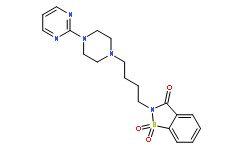| 中文名称: | Ipsapirone | ||||
|---|---|---|---|---|---|
| 英文名称: | Ipsapirone | ||||
| 别名: | TVX Q 7821 free base | ||||
| CAS No: | 95847-70-4 | 分子式: | C19H23N5O3S | 分子量: | 401.48 |
| CAS No: | 95847-70-4 | ||||
| 分子式: | C19H23N5O3S | ||||
| 分子量: | 401.48 | ||||
基本信息
|
产品编号: |
I10304 |
||||
|
产品名称: |
Ipsapirone |
||||
|
CAS: |
95847-70-4 |
储存条件 |
粉末 |
-20℃ |
四年 |
|
|
|
||||
|
分子式: |
溶于液体 |
-80℃ |
6个月 |
||
|
分子量 |
401.48 |
-20℃ |
1个月 |
||
|
化学名: |
2-[4-[4-(2-PYRIMIDINYL)-1-PIPERAZINYL]BUTYL]-1,2-BENZISOTHIAZOL-3(2H)-ONE-1,1-DIOXIDE |
||||
|
Solubility (25°C): |
|||||
|
体外:
|
DMSO |
|
|||
|
Water |
|
||||
|
Ethanol |
|
||||
|
体内(现配现用): |
|
||||
|
<1mg/ml表示微溶或不溶。 |
|||||
|
普西唐提供的所有化合物浓度为内部测试所得,实际溶液度可能与公布值有所偏差,属于正常的批间细微差异现象。 |
|||||
|
请根据产品在不同溶剂中的溶解度选择合适的溶剂配制储备液;⼀旦配成溶液,请分装保存,避免反复冻融造成的产品失效。 |
|||||
生物活性
|
产品描述 |
具有抗焦虑活性的化合物,是 5-HT1A 受体的部分激动剂,也表现出 5-HT1A 受体的拮抗作用,并且只在高剂量时,对 5-HT2 和α1 肾上腺素能表现出抑制作用。 |
|
|
靶点 |
5-HT1A Receptor |
|
|
体内研究 |
Ipsapirone inhibits induced by 8-OH-DPAT and 5-methoxydimethyltryptamine (agonists of 5-HT1A receptors) behavioural effects (flat body posture and forepaw treading) in normal and reserpinized rats . Ipsapirone (2.5-80 mg/kg), given alone to rats induces a slight flattening of body posture (~ 1 point at the highest dose) and a mild hind limb abduction observed at doses 2.5-80 mg/kg. Ipsapirone given alone at low doses (2.5-10 mg/kg i.p.) does not significantly change the body temperature in rats and mice, but decreased it in both those species at high doses (35 mg/kg i.p.) by ca. 2-2.5℃.
|
|
|
Animal Model: |
Male Albino-Swiss mice (18-24 g) and male Wistar rats (160-200 g) |
|
|
Dosage: |
5 and 10 mg/kg. |
|
|
Administration: |
IP 30 min before 8-OH-DPAT and 5-MeODMT injections. |
|
|
Result: |
Behavioural responses (flat body posture, forepaw treading) to 8-OH-DPAT (5 mg/kg s.c.) in rats were antagonized by Ipsapirone (5 and 10 mg/kg i.p.). |
|
本计算器可帮助您计算出特定溶液中溶质的质量、溶液浓度和体积之间的关系,公式为:
质量 (g) = 浓度 (mol/L) x 体积 (L) x 分子量 (g/mol)
摩尔浓度计算公式
用本工具协助配置特定浓度的溶液,使用的计算公式为:
开始浓度 x 开始体积 = 最终浓度 x 最终体积
稀释公式
稀释公式一般简略地表示为:C1V1 = C2V2 ( 输入 输出 )








